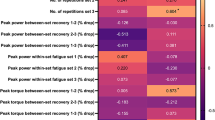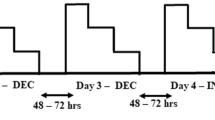Abstract
We attempted to test whether the balance between muscular metabolic capacity and oxygen supply capacity in endurance-trained athletes (ET) differs from that in a control group of normal physically active subjects by using exercises with different muscle masses. We compared maximal exercise in nine ET subjects [Maximal oxygen uptake (VO2max) 64 ml kg−1 min−1 ± SD 4] and eight controls (VO2max 46 ± 4 ml kg−1 min−1) during one-legged knee extensions (1-KE), two-legged knee extensions (2-KE) and bicycling. Maximal values for power output (P), VO2max, concentration of blood lactate ([La−]), ventilation (VE), heart rate (HR), and arterial oxygen saturation of haemoglobin (SpO2) were registered. P was 43 (2), 89 (3) and 298 (7) W (mean ± SE); and VO2max: 1,387 (80), 2,234 (113) and 4,115 (150) ml min−1) for controls in 1-KE, 2-KE and bicycling, respectively. The ET subjects achieved 126, 121 and 126% of the P of controls (p < 0.05) and 127, 124, and 117% of their VO2max (p < 0.05). HR and [La−] were similar for both groups during all modes of exercise, while VE in ET was 147 and 114% of controls during 1-KE and bicycling, respectively. For mass-specific VO2max (VO2max divided by the calculated active muscle mass) during the different exercises, ET achieved 148, 141, and 150% of the controls’ values, respectively (p < 0.05). During bicycling, both groups achieved 37% of their mass-specific VO2 during 1-KE. Finally we conclude that ET subjects have the same utilization of the muscular metabolic capacity during whole body exercise as active control subjects.





Similar content being viewed by others
References
Andersen P, Adams RP, Sjogaard G, Thorboe A, Saltin B (1985) Dynamic knee extension as model for study of isolated exercising muscle in humans. J Appl Physiol 59:1647–1653
Andersen P, Saltin B (1985) Maximal perfusion of skeletal muscle in man. J Physiol 366:233–249
Armstrong RB, Taylor CR (1982) Relationship between muscle force and muscle area showing glycogen loss during locomotion. J Exp Biol 97:411–420
Gallagher D, Visser M, deMeersman RE, Sepulveda D, Baumgartner RN, Pierson RN, Harris T, Heymsfield SB (1997) Appendicular skeletal muscle mass: effects of age gender and ethnicity. J Appl Physiol 83:229–239
Hallen J, Saltin B, Sejersted OM (1996) K+ balance during exercise and role of beta-adrenergic stimulation. Am J Physiol 270:R1347–R1354
Hoppeler H, Weibel ER (2000) Structural and functional limits for oxygen supply to muscle. Acta Physiol Scand 168:445–456. doi:10.1046/j.1365-201x.2000.00696.x
Jones PR, Pearson J (1969) Anthropometric determination of leg fat and muscle plus bone volumes in young male and female adults. J Physiol 204:63P–66P
Magnusson G, Kaijser L, Sylven C, Karlberg KE, Isberg B, Saltin B (1997) Peak skeletal muscle perfusion is maintained in patients with chronic heart failure when only a small muscle mass is exercised. Cardiovasc Res 33:297–306. doi:10.1016/S0008-6363(96)00249-0
Mourtzakis M, Gonzalez-Alonso J, Graham TE, Saltin B (2004) Hemodynamics and O2 uptake during maximal knee extensor exercise in untrained and trained human quadriceps muscle: effects of hyperoxia. J Appl Physiol 97:1796–1802. doi:10.1152/japplphysiol.00169.2004
Radegran G, Blomstrand E, Saltin B (1999) Peak muscle perfusion and oxygen uptake in humans: importance of precise estimates of muscle mass. J Appl Physiol 87:2375–2380
Richardson RS, Frank LR, Haseler LJ (1998) Dynamic knee-extensor and cycle exercise: functional MRI of muscular activity. Int J Sports Med 19:182–187. doi:10.1055/s-2007-971901
Richardson RS, Grassi B, Gavin TP, Haseler LJ, Tagore K, Roca J, Wagner PD (1999) Evidence of O2 supply-dependent VO2 max in the exercise-trained human quadriceps. J Appl Physiol 86:1048–1053
Richardson RS, Kennedy B, Knight DR, Wagner PD (1995a) High muscle blood flows are not attenuated by recruitment of additional muscle mass. Am J Physiol 269:H1545–H1552
Richardson RS, Knight DR, Poole DC, Kurdak SS, Hogan MC, Grassi B, Wagner PD (1995b) Determinants of maximal exercise VO2 during single leg knee-extensor exercise in humans. Am J Physiol 268:H1453–H1461
Richardson RS, Poole DC, Knight DR, Kurdak SS, Hogan MC, Grassi B, Johnson EC, Kendrick KF, Erickson BK, Wagner PD (1993) High muscle blood flow in man: is maximal O2 extraction compromised? J Appl Physiol 75:1911–1916
Roca J, Agusti AG, Alonso A, Poole DC, Viegas C, Barbera JA, Rodriguez-Roisin R, Ferrer A, Wagner PD (1992) Effects of training on muscle O2 transport at VO2max. J Appl Physiol 73:1067–1076
Rowell LB, Saltin B, Kiens B, Christensen NJ (1986) Is peak quadriceps blood flow in humans even higher during exercise with hypoxemia? Am J Physiol 251:H1038–H1044
Rud B, Christensen CC, Ryg M, Edvardsen A, Skumlien S, Hallén J (2008) Higher skeletal muscular metabolic reserve capacity in COPD patients than healthy subjects. Scand J Med Sci Sports. doi:10.1111/j.1600-0838.2008.00846.x
Saltin B (1977) The interplay between peripheral and central factors in the adaptive response to exercise and training. Ann N Y Acad Sci 301:224–231. doi:10.1111/j.1749-6632.1977.tb38201.x
Secher NH, Clausen JP, Klausen K, Noer I, Trap-Jensen J (1977) Central and regional circulatory effects of adding arm exercise to leg exercise. Acta Physiol Scand 100:288–297
Secher NH, Volianitis S (2006) Are the arms and legs in competition for cardiac output? Med Sci Sports Exerc 38:1797–1803. doi:10.1249/01.mss.0000230343.64000.ac
Taylor CR, Weibel ER (1981) Design of the mammalian respiratory system I. Problem and strategy. Respir Physiol 44:1–10. doi:10.1016/0034-5687(81)90073-6
Wagner PD (2000) New ideas on limitations to VO2max. Exerc Sport Sci Rev 28:10–14
Weibel ER, Taylor CR, Hoppeler H (1991) The concept of symmorphosis: a testable hypothesis of structure-function relationship. Proc Natl Acad Sci USA 88:10357–10361. doi:10.1073/pnas.88.22.10357
Author information
Authors and Affiliations
Corresponding author
Rights and permissions
About this article
Cite this article
Rud, B., Hallén, J. Is the balance between skeletal muscular metabolic capacity and oxygen supply capacity the same in endurance trained and untrained subjects?. Eur J Appl Physiol 105, 679–685 (2009). https://doi.org/10.1007/s00421-008-0947-8
Accepted:
Published:
Issue Date:
DOI: https://doi.org/10.1007/s00421-008-0947-8




